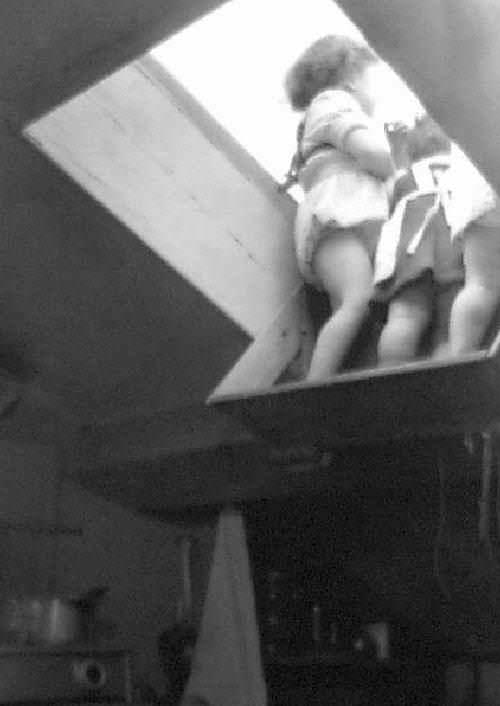
French Rompers: Gender

Figure 1.--Three children can be seen in a French garet in this photograph by the noted French photographer Doisneau. One boy wears romers and a girl wears a skirt. The girl on the right wears a dress and pinafore. Click on the image for a more detailed analisis and another view.
|
A French reader tells HBC that in France girls did not wear rompers which were exclusively an outfit for little boys. They were normally worn by pre-school boys, but HBC has noted rompers made for boys up to 7 years old. Boys wore both play and dressy styled rompers. Girls even for play would wear little dresses. A French reader tells us that this was the accepted convention for rompers. There was nothing preventing a mother from dressing a pre-school girl in rompers if she wanted to, but it was rarely done. The one exception was that mothers on summer holiday would dress girls in "barboteuse bain de soleil". This was a romper sunsuit commonly worn at the beach. The standard one-piece romper, however, was in France exclusively a boys' garment. This convention continued through the 1960s. Eventually as in America, rompers became a style for infants, both boys and girls.
Chronology
The romper or barboteuse in France was primarily a boys garment, but there have been changes over time.
Inter-war era (1920-39)
Rompers were initially a boys garments. Rompers bcame popular in France during the early 1920s. At that time they were only worn by boys. A French reader tells HBC that in France girls did not wear rompers which were exclusively an outfit for little boys. They were normally worn by pre-school boys, but HBC has noted rompers made for boys up to 7 years old. This was quite different from America. Girls even until after World War II in France almost always wore dresses. Boys wore both play and dressy styled rompers. Girls even for play would wear little dresses.
War and post-war years (1939-69)
Catalogs also clearly showed rompers as exclusively boys garment. Even as late as the 1950s in France, only boys were wearing rompers. Images from the 1950s show little boys wearing rompers and little girls of the same age wearing dresses. French mothers during the post-war era continued to see rompers as a boy's style, although they declined somewaht in popularity by the 1960s. A French reader tells us that while rompers as a boys garment was the accepted convention for rompers. There was nothing preventing a mother from dressing a pre-school girl in rompers if she wanted to, but it was rarely done. The one exception was that mothers on summer holiday would dress girls in "barboteuse bain de soleil". This was a romper sunsuit commonly worn at the beach. HBC notes romper sunsuits for girls as beachwear as early as the late 1930s. The standard one-piece romper, however, was in France exclusively a boys' garment. This convention continued through the 1960s. There were play and dressy rompers for boys and play and dressy dreesses for girls. Girls did not wear rompers or other boyish garments like short and long pants. This did not begin to change until the late 1950s.
Late 20th century (1970-2000)
Eventually as in America, rompers became a style for infants, both boys and girls. We have not noted rompers as a style for play suits for pre-school and younger school-age girls as was the case in America during this period. Now both boy and girl infants wear them rompers and they are seen as suitable for both. The only difference may be the color purchased.
Styles
There are several different styles of rompers or romper-like garments. The sandard one-piece romper with back tieing is what the French call a barboteuse. We have never seen any images of girls wearing this standard romper suits or advertisements specifying this garment for girls. We have also not noted girls wearing the two piece dressy romper outfit of a fancy blouce, oftten with puffed sleeves, and romper-style button-on or suspender bottoms. This again was an exclusively boys' style. The only romper-like garment we have noted that girls did occassionally wear was the romper sunsuit. This garment consisted of romper bottoms with a bib-front top. While not commonly worn by girls, younger girls might wear the sunsuit style of rompers as beachwear. Otherwise girls rarely wore any kind of romper outfits.
Christopher Wagner

Navigate the Historic Boys' Clothing Web Site:
[Return to the Main romper page]
[Return to the Main French rompers page]
[Return to the Main romper gender page]
[Introduction]
[Activities]
[Bibliographies]
[Biographies]
[Chronologies]
[Countries]
[Style Index]
[Contributions]
[Frequently Asked Questions]
[French Glossary]
[Main HBC page]
Navigate the Historic Boys' Clothing Web chronological pages:
[The 1890s]
[The 1900s]
[The 1910s]
[The 1920s]
[The 1930s]
[The 1940s]
[The 1950s]
Navigate the Historic Boys' Clothing Web style pages:
[Dresses]
[Smocks]
[Bodice kilts]
[Kilts]
[Sailor suits]
[Sailor hats]
[Ring bearer/page costumes]
[Shortalls]
[French postcards]
[French catalogs]
Created: October 15, 2001
Last updated: November 22, 2001



